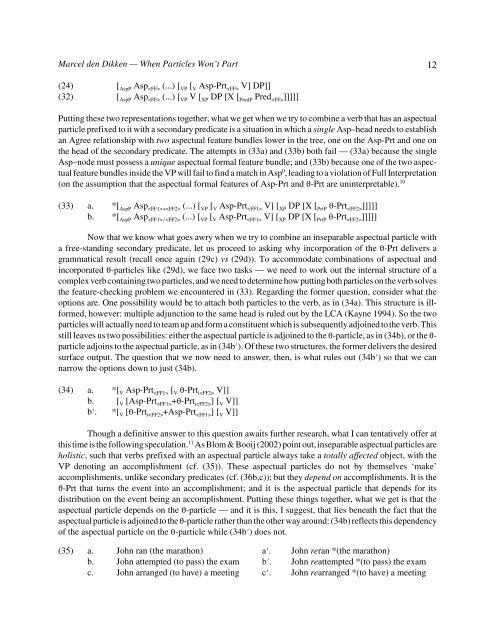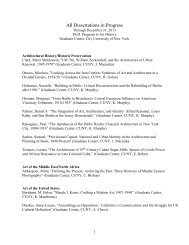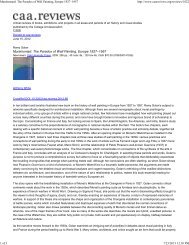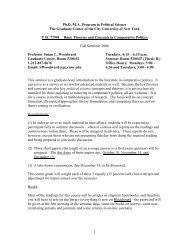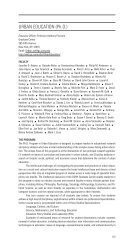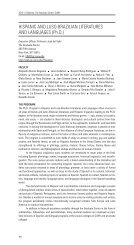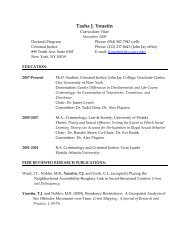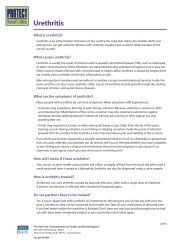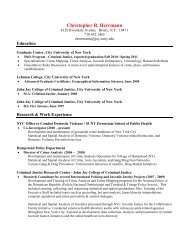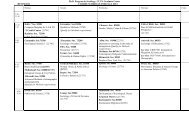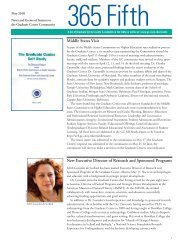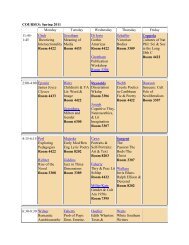When Particles Won't Part - CUNY Graduate Center
When Particles Won't Part - CUNY Graduate Center
When Particles Won't Part - CUNY Graduate Center
Create successful ePaper yourself
Turn your PDF publications into a flip-book with our unique Google optimized e-Paper software.
Marcel den Dikken — <strong>When</strong> <strong><strong>Part</strong>icles</strong> Won’t <strong>Part</strong><br />
(24) [ AspP Asp (...) [ VP [ V Asp-Prt V] DP]]<br />
(32) [ AspP Asp (...) [ VP V [ XP DP [X [ PredP Pred ]]]]]<br />
Putting these two representations together, what we get when we try to combine a verb that has an aspectual<br />
particle prefixed to it with a secondary predicate is a situation in which a single Asp–head needs to establish<br />
an Agree relationship with two aspectual feature bundles lower in the tree, one on the Asp-Prt and one on<br />
the head of the secondary predicate. The attempts in (33a) and (33b) both fail — (33a) because the single<br />
Asp–node must possess a unique aspectual formal feature bundle; and (33b) because one of the two aspectual<br />
feature bundles inside the VP will fail to find a match in Asp 0 , leading to a violation of Full Interpretation<br />
(on the assumption that the aspectual formal features of Asp-Prt and 2-Prt are uninterpretable). 10<br />
(33) a. *[ AspP Asp + (...) [ VP [ V Asp-Prt V] [ XP DP [X [ PrtP 2-Prt ]]]]]<br />
b. *[ AspP Asp / (...) [ VP [ V Asp-Prt V] [ XP DP [X [ PrtP 2-Prt ]]]]]<br />
Now that we know what goes awry when we try to combine an inseparable aspectual particle with<br />
a free-standing secondary predicate, let us proceed to asking why incorporation of the 2-Prt delivers a<br />
grammatical result (recall once again (29c) vs (29d)). To accommodate combinations of aspectual and<br />
incorporated 2-particles like (29d), we face two tasks — we need to work out the internal structure of a<br />
complex verb containing two particles, and we need to determine how putting both particles on the verb solves<br />
the feature-checking problem we encountered in (33). Regarding the former question, consider what the<br />
options are. One possibility would be to attach both particles to the verb, as in (34a). This structure is illformed,<br />
however: multiple adjunction to the same head is ruled out by the LCA (Kayne 1994). So the two<br />
particles will actually need to team up and form a constituent which is subsequently adjoined to the verb. This<br />
still leaves us two possibilities: either the aspectual particle is adjoined to the 2-particle, as in (34b), or the 2particle<br />
adjoins to the aspectual particle, as in (34bN). Of these two structures, the former delivers the desired<br />
surface output. The question that we now need to answer, then, is what rules out (34bN) so that we can<br />
narrow the options down to just (34b).<br />
(34) a. *[ V Asp-Prt [ V 2-Prt i V]]<br />
b. [ V [Asp-Prt +2-Prt i] [ V V]]<br />
bN. *[ V [2-Prt i+Asp-Prt ] [ V V]]<br />
Though a definitive answer to this question awaits further research, what I can tentatively offer at<br />
this time is the following speculation. 11 As Blom & Booij (2002) point out, inseparable aspectual particles are<br />
holistic, such that verbs prefixed with an aspectual particle always take a totally affected object, with the<br />
VP denoting an accomplishment (cf. (35)). These aspectual particles do not by themselves ‘make’<br />
accomplishments, unlike secondary predicates (cf. (36b,c)); but they depend on accomplishments. It is the<br />
2-Prt that turns the event into an accomplishment; and it is the aspectual particle that depends for its<br />
distribution on the event being an accomplishment. Putting these things together, what we get is that the<br />
aspectual particle depends on the 2-particle — and it is this, I suggest, that lies beneath the fact that the<br />
aspectual particle is adjoined to the 2-particle rather than the other way around: (34b) reflects this dependency<br />
of the aspectual particle on the 2-particle while (34bN) does not.<br />
(35) a. John ran (the marathon) aN. John reran *(the marathon)<br />
b. John attempted (to pass) the exam bN. John reattempted *(to pass) the exam<br />
c. John arranged (to have) a meeting cN. John rearranged *(to have) a meeting<br />
12


